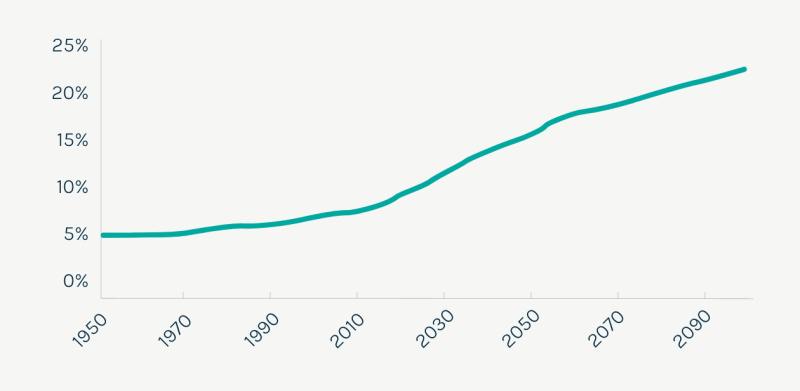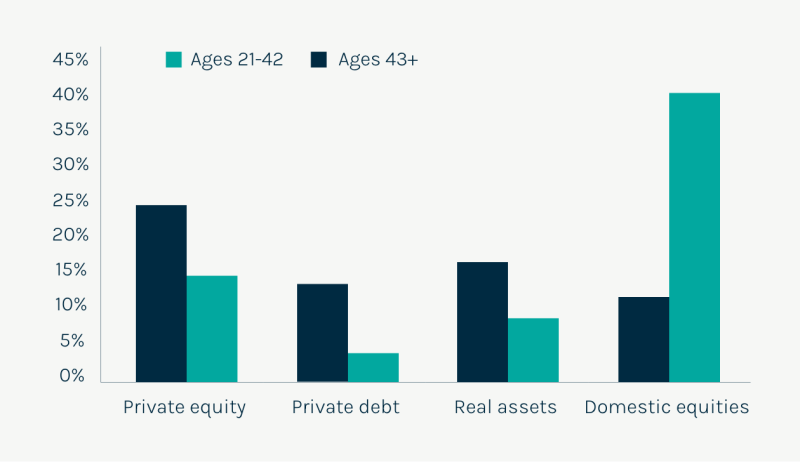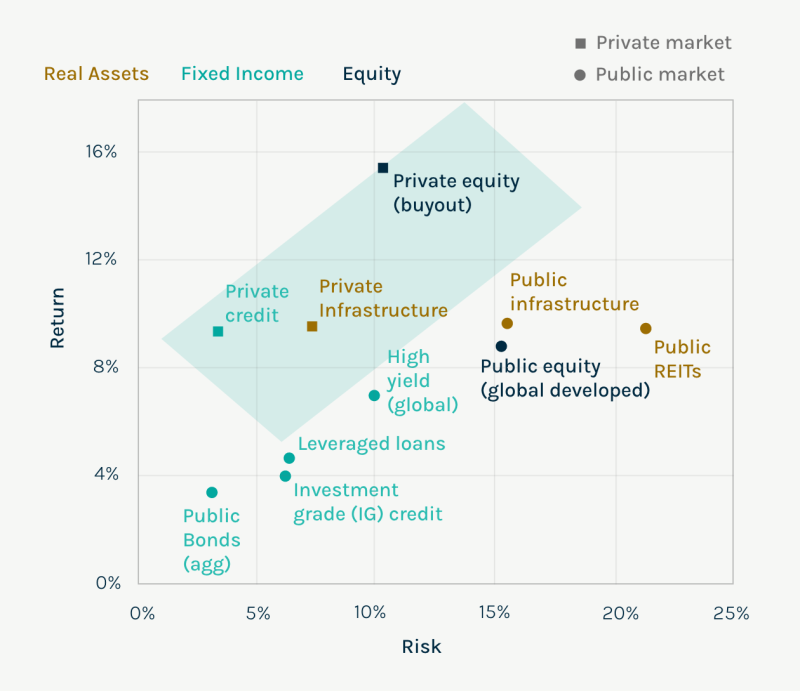Wealth accumulation of past generations has relied heavily on the returns of public equity. However, we see demographic shifts of wealth holders pushing changes in today’s capital markets. Today, due to changing investment objectives of an aging population, we sit at an inflection point—the Great Wealth Transfer—whereby ~$84 trillion in wealth will change hands from one generation to the next.1
In order to effectively build portfolios for the future that will deliver similar wealth accumulation potential as those of the past, we believe we must acknowledge that the nature of equity ownership has changed. Public stocks, once the only way to access broad ownership of the American economy, are a shrinking and more concentrated universe. Private companies more closely resemble what equity was in its early days. What public equity did for prior generations is what private equity can potentially do for future generations in their same quest for wealth accumulation.
We believe private markets, incorporated thoughtfully to complement equity-centric public market portfolios, will play a crucial role in future wealth accumulation.
The Great Wealth Transfer
The largest holders of wealth are still the baby boomers (ages 56–74), but this sizeable post-World War II generation is retiring alongside a shrinking of working-age populations. Over the next 20 years, the global population aged 65 and older is projected to grow by more than 50% (see below).
Proportion of the Global Population Aged 65 and Older, %
Further, by 2024, baby boomer households will be passing on more wealth annually than any other generation, a lead that is expected to rise until the 2040s (see below).
Annual Percent of Wealth Transfer by Source Generation, 2021–2045
More than $53 trillion will be transferred from baby boomer households, making up 63% of all transfers.
As this cohort retires, its need for investment income grows. Furthermore, risk tolerance shifts toward a more conservative profile. In fact, assuring a comfortable retirement and protecting current levels of wealth are the two most important financial goals cited by the 65 and older crowd.2
Most important financial goals by investable assets, 2Q 2021
| Most important financial goal | Household investment assets | All affluent respondents | ||
| $1m–$2m | $2m–$5m | >$5m | ||
| Assure comfortable standard of living in retirement | 43% | 38% | 30% | 41% |
| Protect current level of wealth | 29% | 33% | 28% | 30% |
| Aggressively grow wealth | 7% | 6% | 12% | 7% |
| Improve household cash flow | 7% | 6% | 4% | 7% |
| Better manage market risk | 4% | 5% | 8% | 4% |
| Leave an estate for heirs | 4% | 4% | 7% | 4% |
| Minimize income and capital gains taxes | 3% | 4% | 4% | 4% |
| College education financing | 2% | 2% | 0% | 2% |
| Charitable giving | 1% | 1% | 6% | 1% |
| Other | 1% | 1% | 1% | 1% |
Traditionally, both stated goals would likely correspond to an increase in the allocation to public fixed income.
By contrast, those inheriting the wealth, the “next gen” inheritors (ages 21–42), tend to seek above-average returns given a longer time horizon until retirement age and the benefits of compounding returns in the years leading up to when they ultimately retire. This is traditionally associated with a more aggressive asset allocation and would be accomplished via a higher allocation to public equities. But most next gen-ers (75%) do not believe in the ability of traditional stocks and bonds to achieve those goals (see below).
Not possible to achieve above-average returns solely on traditional stocks and bonds.
In fact, private equity, private debt and real assets all rank above traditional equity as investments that offer the greatest opportunities for growth among this group(see below).
Investments that offer the greatest opportunities for growth
Humans are creatures of instinct. And if the preferences of next gen investors are any indication, instinct, coupled with recent market challenges create …the nagging feeling that there must be a better way.
What’s New Is Old—Private Markets as an Expanded Investment Toolkit
Ultimately, the investment objective of most investors is that of wealth accumulation. This means a certain level of investment return must be reasonably expected, and for that return, a certain level of risk must be assumed.
By expressing a disbelief in traditional stocks and bonds to sufficiently achieve the wealth accumulation goal, next gen-ers are inherently saying they would be taking the same or more risk as in the past—but are unconvinced they will receive the same level of return. What is needed are new portfolio construction tools that can potentially deliver similar or better returns for similar or less risk than public markets.
Private markets, now accessible to a broader universe of clients through evolved structures, are those tools.
The use of private markets in portfolios to meaningfully enhance outcomes and experiences is not new. These strategies have been in use for decades for qualified purchasers (institutional pools like endowments, pension plans and insurance companies, as well as ultra-high net worth investors).
What is new is the format of these same strategies, which has evolved and renders private markets to be viable asset classes for those with lower levels of investable assets. It is for this reason we believe it is more appropriate to consider them to be a part of an expanded toolkit, a newly available solution to an age-old problem.
Ultimately, investment performance is fairly agnostic to product structure. So the relevant question, when considering them for use in any portfolio, comes back to risk and return.
From an Expanded Toolkit to Enhanced Outcomes and Experience
We believe the lower risk, higher returns and lower correlations of the private markets help them fit incredibly well into the traditional portfolios. By taking advantage of the differentiated risk/return profile of private markets, we believe investors will see enhanced outcomes (more dollars in their account at retirement and beyond) as well as a better experience (more muted changes in account balances). And we believe that’s something investors of any age, from boomer to next gen, can all agree on.










